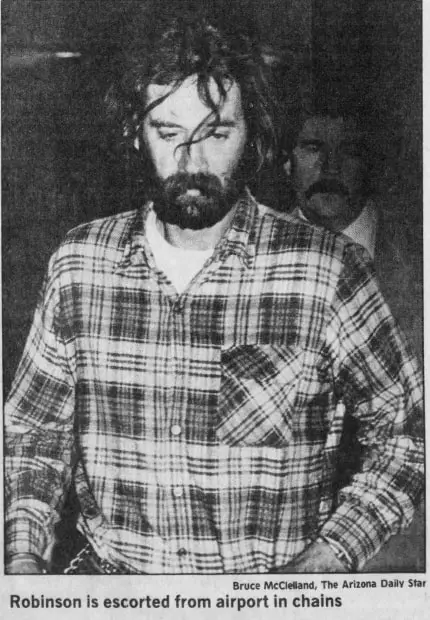TUCSON, Ariz. — Diane Marie Hundt was born in 1968 to Richard and Irene Hundt, the oldest of four children. She was considered shy and an introvert. She was a junior at Sahuaro High School, where she was in a class for the emotionally handicapped.
On Dec. 31, 1985, Diane, 17, fled her family home at 9:45 p.m. after arguing with her parents. Her father, Richard Hundt, said the argument was “nothing that was out of the ordinary for lots of families.”
“She said, ‘I got to get out of here.’ I told her to stay and talk to me about it, I wouldn’t laugh at her,” Richard said.
When Diane failed to come home the following day, Richard filed a runaway juvenile report with the Tucson Police Department.
Diane had cut her hair into a “punk style,” very short on the sides and “round on top,” Hundt said. He felt she did it because she had a low opinion of herself.
On New Year’s Day 1986, bow hunters found Diane’s body in the desert in northeast Tucson near North El Camino Rinconado and East Tanque Verde Road. She was identified through dental records. The autopsy showed Diane was strangled to death with her bra and had been killed sometime between 1:00 a.m. and 10:00 a.m. New Year’s Day.
Diane had no history of drug abuse, and police did not believe she had been hitchhiking before her disappearance.
A few days after Diane’s murder, a transient named Kerry Wayne Robinson, 31 years old, called the Riverside County Sheriff’s Department in California and asked if he was wanted on any warrants. Riverside authorities had no explanation for why Robinson would make such a call.
Shortly after, Riverside officials arrested Robinson in a phone booth at 3:40 p.m. on Jan. 2, 1986, on a May 1985 warrant for driving under the influence. While in custody, Robinson said he had information about the death of a youth who he believed died in Tucson. The child was a 16- or 17-year-old female who had overdosed on drugs at a party Robinson attended.
Detective Thomas Petropoulos of the Pima County Sheriff’s Office flew to Riverside to question Robinson over Diane Marie Hundt’s murder a few days later.
On Monday, Jan. 6, 1986, Robinson was flown to Tucson, and authorities booked him on a first-degree murder charge in Pima County Jail for Diane’s murder. Bond was set at $1 million.

Witness testimony at a preliminary court hearing produced three different accounts of Kerry Wayne Robinson’s whereabouts on the day Diane vanished.
Danny George LaBounty, 39, of Arlington, Illinois, and Perris, California, testified that he picked up Robinson while driving near Ryan, Louisiana, on Dec. 31, 1985. LaBounty said Robinson was originally going to Tucson but changed his mind and drove with LaBounty to Perris.
LaBounty testified that Robinson was driving when they passed through Tucson. They arrived in Perris about midnight on New Year’s Day, stopping only for gas and sandwiches and never for more than 10 minutes at a time.
But LaBounty’s alibi conflicted with two different accounts Robinson gave Detective Petropoulos during several interviews in Riverside and Tucson.
During interviews on Jan. 2, Jan. 3, and Jan. 6, Robinson said he had attended a party in the desert near “Redding Pass or Redding Lake.” Some young girls and a man called Stix were also at the party. The group ate peyote buttons during the party, drank wine, and smoked marijuana.
One of the girls called Robinson a drug addict and transient. He slapped her, and then he was hit in the head with a rock. Stix later told him something had happened, and he thought the girl was dead.
Robinson described to police the clothing the girl was wearing. It was similar to Diane’s. He also described her as having a “punk style” haircut.
At times, Robinson was unsure whether he killed the young girl, and at other times, he specifically denied doing so. Asked how he would have killed her if he did, Robinson said he would probably choke her or hit her with a rock.
On Jan. 7, Detective Petropoulos and another investigator accompanied Robinson to the Reddington Pass area. He took the detectives about two miles from where Diane’s body was found.
Petropoulos did not believe “Stix” actually existed. At one location, they found an old abandoned van. He asked Robinson if it was the van belonging to Stix. Robinson then admitted to Petropoulos that his first account was a lie.
Robinson told detectives he had seen a girl arguing with “some guys” in or near Reddington Pass. The girl had “ripped off some drugs,” Petropoulos testified. The autopsy showed no drugs or alcohol in Diane’s system. During the Jan. 7 interview, Robinson said he strangled Diane with a bra. When pressed by police, Robinson denied being in Tucson at the time of her death and said LaBounty could provide him an alibi.
Robinson’s lawyer, Assistant Public Defender George Erickson, argued to Judge Thomas Meehan that the only verifiable evidence was the alibi provided by LaBounty. He said the remaining evidence centered on Detective Petropoulos’ first interview with Robinson in Riverside in the early morning hours of January 3, 1986. That interview was not taped, as were others, and the court had to rely exclusively on Petropoulos’ version of it (Turner, 1986).
Judge Thomas Meehan found sufficient evidence for Robinson’s prosecution despite an alibi and two different versions of Robinson’s whereabouts on the night of Diane’s murder. Therefore, Robinson would stand trial for the murder.
Meehan didn’t believe that Robinson could give such a detailed description of Diane and the manner of her death without being at the crime scene. However, no trial date was set at that time.
In late April 1986, the murder charges against Robinson were dropped due to insufficient evidence.
Analysis of hairs and seminal fluid found on Diane’s body showed they were not from LaBounty or Robinson.
Robinson said Detective Petropoulos asked leading questions, which made it easy for him to get the details of the crime right.
No one else has ever been charged with Diane’s murder, and her case remains unsolved.
True Crime Diva’s Thoughts
The first thing I am starting off with is something I discovered after seeing Robinson’s picture.
A few weeks ago, I was researching the Springfield Three case. At one time, police were looking for a transient seen in the area of Sherrill Levitt’s home around the time of the disappearances.
When I saw a picture of Robinson, my heart stopped. He bears a striking resemblance to the composite sketch of the transient in Springfield, he’s around the same age, and was a transient, too.

The transient in Springfield was between 34-38 years old in 1992. Robinson would have been 37 or 38 in ’92. I could not find any more info on Robinson after 1986. There is a slight difference in the composite sketch, but those are never 100% accurate. It’s a long shot, but you never know.
Charges against Robinson were dropped in Diane Marie Hundt’s case because the hair and seminal fluid found at the crime scene did not come from Robinson. The reason he told Riverside authorities that he had info on Diane’s murder was that he was hoping they would squash his DUI charge if he offered up something in return.
In Diane’s case, there were no sightings of her after she left her family home, not by friends or strangers.
The autopsy showed she was killed sometime between 1 am and 10 am New Year’s Day. She left home at 9:45 pm on New Year’s Eve. That leaves a few hours where she was alive. Where was she? Was she held for a brief period of time?
I wonder what the family situation was really like. Why did her father file a runaway juvenile report instead of a missing person report? Had she run away before? If so, for how long? I didn’t find anything about that, but in one article, the father said she “was not usually out of the house after dark.” So, it seems strange to file a runaway report for that reason and also because she was 17, nearly an adult.
As they say, you never know what goes on behind closed doors.
Source
Turner, Mark. 1986a. “Testimony Conflicts, Alibi Given in New Year’s Day Strangulation.” Arizona Daily Star. January 24.
—. 1986b. “Judge Finds Enough Evidence to Try Man in Girl’s Strangulation.” Arizona Daily Star. January 25.
—. 1986c. “Man Freed in Killing Tells How He Knew So Much.” Arizona Daily Star. April 30.



